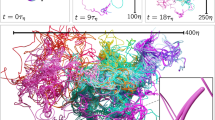Abstract
The sandy shores of ocean beaches deform under the continual action of waves and currents into a rich set of patterns and morphologies with scales from centimeters to kilometers. Since the bathymetry acts as a boundary condition to the progressing waves and those waves also slowly modify the bathymetry, an important feedback loop exists. It appears to be this feedback that causes observed nearshore morphologies, rather than the sand simply responding to a pattern of forcing imposed by the fluids. Because interactions between the fluid and sediment are inherently nonlinear, they can be complicated to study. For weak nonlinearities, perturbation techniques are available, or the system may be modeled numerically in a series of small time steps. However, as the time scales of interest extend, small errors in forward stepping models grow exponentially and other approaches are needed. Self organization models study the phenomenology that is derived from very simple feedback loops, felt to represent the essence of the nearshore system and implemented by sets of rules. Top down modeling examines long time series of field data to extract empirically the basic physics required to explain the observed phenomenology. Merging the results of these approaches will facilitate progress.
Access this chapter
Tax calculation will be finalised at checkout
Purchases are for personal use only
Preview
Unable to display preview. Download preview PDF.
Similar content being viewed by others
References
Abarbanel, H. D. I. (1995) Analysis of observed chaotic data. Springer-Verlag, New York, 272 pp
Barcilon, A. I., Lau, J. P. (1973) A model for the formation of transverse bars. J. Geophys. Res. 78, 2656–2664
Boczar-karakiewicz, B., Davidson-Arnott, R. G. D. (1987) Nearshore bar formation by non-linear wave processes — A comparison of model results and field data. Marine Geology 77, 287–304
Bowen, A. J. (1969) Rip currents, 1. Theoretical investigations. J. Geophys. Res. 74, 5467–5478
Bowen, A. J. (1980) Simple models of nearshore sedimentation; beach profiles and longshore bars. In: McCann S.B. (ed) The Coastline of Canada, Geological Survey of Canada, 1–11
Carter, T. G., Liu, P. L., Mei, C. C. (1973) Mass transport by waves and offshore sand bedforms. Journal of the Waterways, Harbors and Coastal Engineering Division, WW2, 165–184
Falques, A. (1991) A note on the Barcilon and Lau model for transverse bars. Review de Geofisica 47, 191–195
Guza, R. T., Inman, D. L. (1975) Edge waves and beach cusps. J. Geophys. Res. 80, 2997–3012
Guza, R. T., Thornton, E. B. (1982) Swash oscillations on a natural beach. J. Geophys. Res. 87, 483–491
Holland, K. T., Holman, R. A. (1996) Field observations of beach cusps and swash motions. Mar. Geol. 134, 77–93
Holland, K. T., Holman, R. A. (1999) Wavenumber-frequency structure of infragravity swash motions. J. Geophys. Res. 106 (C6), 13479–13488
Holman, R. A., Sallenger, A. H., Jr. (1985) Setup and swash on a natural beach. J. Geophys. Res. 90 (Cl), 945–953
Howd, P. A., Oltman-Shay, J, Holman, R. A. (1991) Wave variance partitioning in the trough of a barred beach. J. Geophys. Res. 96 (C7), 12,781–12, 795
Inman, D. L. (1957) Wave-generated ripples in nearshore sands. U.S. Army Corps of Engineers, Beach Erosion Board, 66 pp
Kennedy, J. F. (1963) The mechanics of dunes and antidunes in erodible-bed channels. J. Fluid Mech. 16, 521–544
Komar, P. D. (1974) Oscillatory ripple marks and the evaluation of ancient wave conditions and environments. J. Sediment. Petrol. 44, 169–180
Komar, P. D. (1976) Beach Processes and Sedimentation. Prentice-Hall, Englewood Cliffs, NJ, 429 pp
Konicki, K. M., Holman R. A. (in review) Transverse sand bars in the nearshore. Mar. Geol.
Miche, R. (1951) Le pouvoir réfléchissant desouvrages maritimes exposés à l’action de la houle. Ann. Ponts Chaussees 121, 285–319
Neidoroda, A. W., Tanner, W. F. (1970) Preliminary study of transverse bars. Mar. Geol. 9, 41–62
Philander, S. G. (1990) El Nino. La Nina and the Southern Oscillation. Academic Press, San Diego
Plant, N. G., Holman, R. A., Freilich, M. H. (in press): A simple model for interannual sand bar behavior. J. Geophys. Res.
Ranasinghe, R., Symonds. G., Holman, R. A. (in review) Rip spacing and persistence on a swell dominated beach. J Geophys. Res.
Short, A. D. (1975) Multiple offshore bars and standing waves. J. Geophys. Res. 80, 3838–3840
Traykovski, P., Hay, A. E., Irish, J. D., Lynch, J. F. (1999) Geometry, migration and evolution of wave orbital ripples at LEO-15. J. Geophys. Res. 104 (C1), 1505–1524
Werner, B. T., Fink, T.M. (1993) Beach cusps as self-organized patterns. Science 260, 968–971
Wijnberg, K. M., Holman, R. A. (in review) Shoreward propagating accretionary waves in the nearshore. J. Geophys. Res.
Wijnberg, K. M., Terwindt, J. H. J. (1995) Extracting decadal morphological behavior from high-resolution, long-term bathymetric surveys along the Holland coast using eigenfunction analysis. Mar. Geol. 126, 301–330
Author information
Authors and Affiliations
Editor information
Editors and Affiliations
Rights and permissions
Copyright information
© 2001 Springer-Verlag Berlin Heidelberg
About this chapter
Cite this chapter
Holman, R. (2001). Pattern Formation in the Nearshore. In: Seminara, G., Blondeaux, P. (eds) River, Coastal and Estuarine Morphodynamics. Springer, Berlin, Heidelberg. https://doi.org/10.1007/978-3-662-04571-8_7
Download citation
DOI: https://doi.org/10.1007/978-3-662-04571-8_7
Publisher Name: Springer, Berlin, Heidelberg
Print ISBN: 978-3-642-07530-8
Online ISBN: 978-3-662-04571-8
eBook Packages: Springer Book Archive




